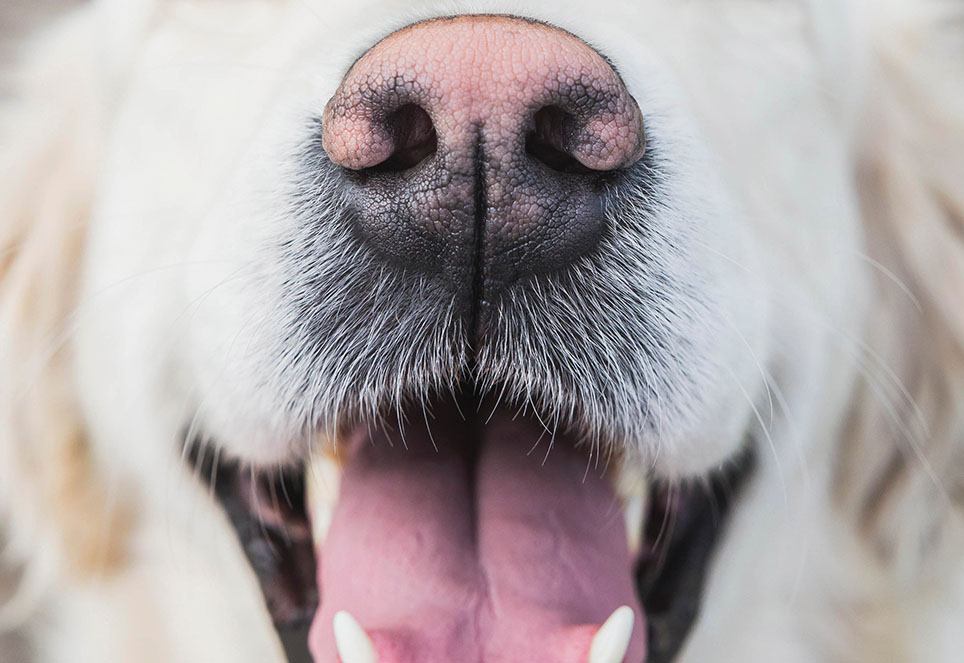Just like many people, dogs love basking in the warm rays of the sun. However, dogs can also suffer from painful sunburn. With the right protection, you can prevent burns on sensitive areas of your dog.
Summer brings many wonderful opportunities for dog owners to spend time outdoors with their beloved four-legged friends. Whether at the dog beach, by the lake, or during summer vacations, it’s most enjoyable when your furry best friend is with you.
To fully enjoy good weather and sunshine, it’s important to pay attention to necessary protection to prevent sunburn. This way, summer days together can be cherished as beautiful memories.
How to recognize sunburn in dogs?
In cases of acute sunburn in your dog, affected skin areas are red, and scales or crusts may form. The burned skin looks inflamed and may develop blisters in severe cases of sunburn. Symptoms include intense itching and pain. If your dog scratches or licks excessively after sunbathing, it could be a sign of possible sunburn.
Where can a dog get sunburned?
Almost every dog has areas on the body that are not covered by protective fur. The skin in these areas is particularly thin and sensitive. Examples include:
- The dog’s nose: nose pad and front snout area
- Lips and the inner ears
- Less-furred areas of the abdomen
- Inner thighs
- Anal and genital region

Is sunburn dangerous for dogs?
Just like humans, dogs can develop skin cancer. Each sunburn increases this risk. When the upper layers of the skin are damaged by excessive UV rays, they can no longer be nourished with nutrients, leading to cell death and rejection by the body. Fluid may accumulate between the skin layers, making the skin susceptible to bacterial infections.
First aid – what to do for sunburn in dogs?
Despite precautions, dogs can still get sunburned. In such cases, the first step is to find a shaded area. You can then cool the affected areas with cold compresses.
Prevent further skin dehydration and apply a moisturizing lotion to the affected areas. Be cautious about avoiding colorants, preservatives, or perfumes, as they can further dry out the skin.
For severe burns, seek professional treatment at a veterinary clinic. There, decisions can be made about the use of anti-inflammatory agents such as cortisone to prevent potential infections.
Additionally, ensure that your dog does not scratch excessively due to itching. Additional symptoms such as circulatory problems, lethargy, or vomiting are signs of heatstroke. In such cases, promptly consult a veterinarian.
How to prevent sunburn in dogs
During hot temperatures, take conscious measures to prevent your dog from getting sunburned. Here’s what you can do to enjoy the summer together carefree:
Avoid direct sunlight:
To protect your dog from sunburn, avoid prolonged exposure to direct sunlight, especially during the peak of summer. Choose shaded areas for walks, such as a forest. Schedule extended walks during the morning or evening hours in the summer heat to protect your dog from both sunburn and excessive heat.
Seek and provide shade:
If outdoor time during intense sunlight is unavoidable, ensure your dog always has the option to retreat to the shade. A parasol or beach tent can be helpful if natural shade is not available.
Apply sunscreen:
You can also protect your dog with a suitable sunscreen. Ensure the product is safe for dogs, using either specialized dog sunscreen or a human sunscreen free of ingredients like silicone and perfume, as the cream may be licked off. Baby sunscreens with high sun protection factor (SPF 30 or 50) are suitable. Apply the sunscreen to hairless body parts and let it absorb before going outside. For particularly sensitive breeds, it may be beneficial to apply it to the entire body for protection.
Proper coat care:
Many dog owners trim their furry friends’ coats, especially in summer. However, this may not always be beneficial. The coat serves not only as protection against cold but also against excessive sun exposure. The undercoat, in particular, has insulating properties in both low and high temperatures. Shaving the coat disrupts these functions. Numerous dog breeds require proper brushing or trimming rather than cutting.
Protective clothing against sunburn:
Another option to protect dogs from sunburn is to dress them in clothing with special UV protection. However, this method is only recommended to a limited extent as it can trap heat underneath. For hikes in mountainous areas with lower temperatures but higher UV radiation, dressing your dog in a suitable shirt may be useful.
Which dogs are particularly vulnerable to sunburn?
In general, all dogs can get sunburned if exposed to the sun for too long. However, certain dogs are more susceptible. These include:
- Dogs with white or light-colored fur
- Dogs with a light, pink nose
- Short-haired dog breeds
- Hairless dog breeds
- Breeds with short snouts
- Puppies and young dogs
Dark, long-haired dogs may suffer more in the heat than light-colored ones because their fur retains heat. Nevertheless, light-colored dogs with short fur are more prone to sunburn. White dogs with pink noses or lips, in particular, need additional protection due to their light pigmentation, making them more susceptible to strong UV radiation.
Short-haired breeds with little undercoat, such as Dalmatians, Bull Terriers, or Magyar Vizslas, are also very sensitive to the sun. The same applies to hairless breeds like the Chinese Crested, Xoloitzcuintli, or Peruvian Inca Orchid. These breeds are directly exposed to the sun without protective fur and can easily get burned.
The higher risk for short-nosed breeds like Pugs or French Bulldogs to get sunburned is less obvious. Due to their anatomy, these dogs often cannot keep their noses moist, leading to dry and cracked skin, making them particularly susceptible to sunburn.
Young dogs and puppies also have a higher risk of getting sunburned. Their skin is still sensitive, and they have not developed the protective pigmentation that makes sunbathing less risky in later years.
In summary – what to look out for
To be ready for quality outdoor time and enjoy the sun worry-free, a bit of preparation is all it takes.
To avoid problems with strong sunlight, you should:
- Gather information. Does your dog have a particular risk of sunburn?
- Consider appearance. Light-colored and short-haired dogs are generally more susceptible to sunburn.
- Think about special factors. Short-nosed breeds or puppies have a higher risk.
- Take preventive measures in time. Avoid sunburn through adequate shade, sunscreen, coat care, or protective clothing.
- Know the symptoms. Recognize sunburn by red or dry skin areas; your dog may scratch frequently.
- Be able to apply first aid. In cases of acute sunburn, apply cream and cool the affected skin areas.
- Seek help if necessary. Consult a veterinarian promptly for severe burns or sunstroke.


